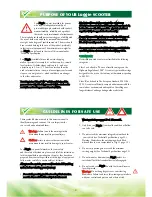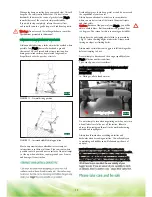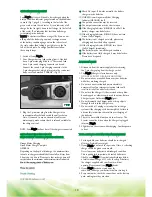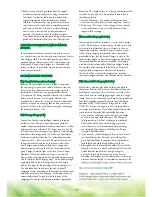
FIGURE 11 : Normal driving position
FIGURE 12 : Increased stability driving position
Most new pavements have wheelchair access ramps at
intersections, use these at all times. Plan your route where
possible to avoid poor and uneven surfaces. Do not attempt
to ride up or down kerbs as you may ground your Scooter
and damage it's construction.
Care must be taken when attempting to drive over soft
surfaces such as those found in parks etc. The surface may
look level, but this can be deceiving and hidden dangers may
make your Luggie become unstable or grounded.
CONTROL OVER GRASS & GRAVEL ETC.
CONTROL OVER GRASS & GRAVEL ETC.
Luggie
FIG 12
Anti-tipping wheels
Anti-tipping wheels
Do not attempt to turn when negotiating an incline, only turn
when all wheels are fully on or off the incline; failure to
observe this warning could result in the machine becoming
unstable and toppling over.
Always lean forward when ascending an incline and
backwards when decending an incline. This will enable you
to maintain good stability and will eliminate any chance of
an upset.
PLEASE NOTE: The rear stability of your Scooter is
dependent on a number of factors which you should consider
before attempting to climb an incline or other obstacle:
(a) your height; (b) the height of your seat; (c) your weight
and (d) the angle of the incline you are attempting to climb.
All of these factors can affect the rear stability of your
Luggie Scooter. If you are unsure of your capability to climb
an obstacle, then try another route - always think 'safety first'.
Please take care and be safe
PLEASE NOTE: The rear stability of your Scooter is
dependent on a number of factors which you should consider
before attempting to climb an incline or other obstacle:
(a) your height; (b) the height of your seat; (c) your weight
and (d) the angle of the incline you are attempting to climb.
All of these factors can affect the rear stability of your
Luggie Scooter. If you are unsure of your capability to climb
an obstacle, then try another route - always think 'safety first'.
Please take care and be safe
FIG 10
FIG 11
When going down an incline, keep your speed slow. This will
keep you in a safely controlled descent. It is best to lean
backwards, this moves the centre of gravity of your Luggie
towards the rear of the scooter for improved stability.
If you wish to stop completely, release the control lever,
and you will come to a gentle stop, avoid sudden stop starts.
Do not exceed the incline guidelines or any other
specifications presented in this manual.
Stationery obstacles (steps, kerbs etc) must be avoided where
possible. Your Luggie has small wheels and a ground
clearance of 4.0cm. Proceed with extreme caution when
driving near raised surfaces, unprotected ledges and/or
dropoffs such as kerbs, porches, stairs etc.
Warning :
CONTROL OVER STATIONARY OBSTACLES
Luggie
Luggie
Warning :
CONTROL OVER STATIONARY OBSTACLES
Avoid unkept grass, loose deep gravel or sand, do not exceed
the capabilities of your Scooter.
Always have an attendant to assist you in circumstances
where you are not certain of the terrain. Always anticipate
and think safety.
Because of the power of your Luggie , you will be
able to climb inclines. But the maximum safe gradient limit
is 6 degrees. The reason for this is to ensure good stability.
Always have the anti-tipping wheels fitted to your machine
( Fig 12 ) when climbing angles or obstacles. Always avoid
turning on slopes or climbing kerbs.
Always make certain that your Luggie is in full working order
before attempting to drive.
Never attempt to drive beyond the design capability of your
Luggie. Observe weather conditions.
Tyres can slip on wet or icy surfaces.
DO NOT DRIVE THROUGH DEEP WATER OR LEAVE
YOUR Luggie EXPOSED TO
HEAVY RAIN.
i.e. During or after a thunderstorm.
Caution :
Caution :
Luggie
Luggie
DO NOT DRIVE THROUGH DEEP WATER OR LEAVE
YOUR Luggie EXPOSED TO
HEAVY RAIN
15














































